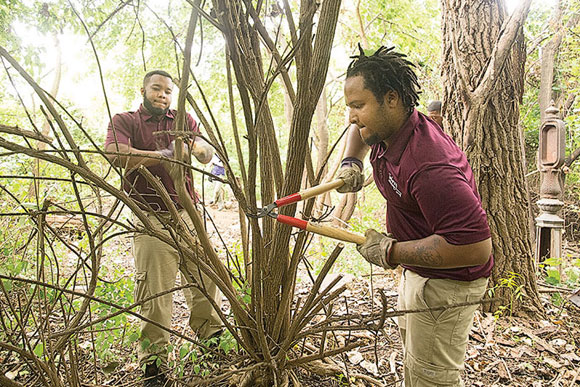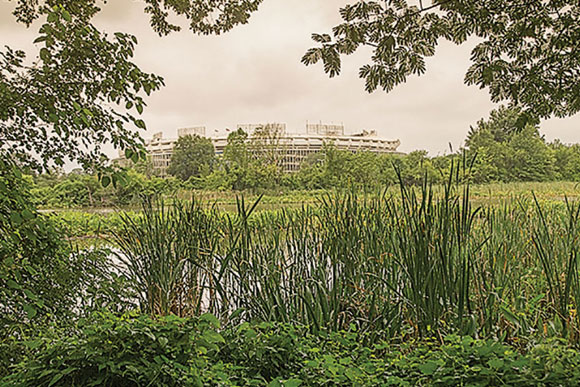Driving across Interstate 295, parking in a concrete lot near RFK Stadium and walking through a tall iron gate, it’s hard to imagine what awaits on the other side.
A wide footbridge sprawls out ahead, spanning a section of the Anacostia River that’s almost unrecognizable. Rather than the trash-strewn and polluted scenes associated with the District of Columbia’s “forgotten river,” here, wetlands flourish along the banks where the river parts around man-made Kingman and Heritage islands.
In 1916, the U.S. Army Corps of Engineers dredged the mud flats that were here — and thought to be a breeding ground for disease-carrying mosquitoes — to create the islands as the home for a recreational park in the middle of a growing metropolis.
But no money was set aside to make the park. The space languished. Airports and amusement parks were proposed over the years to make better use of the land. The islands were used for decades as unofficial dumping grounds, and old washers and refrigerators are still found hidden among the brush.
Residents started to speak up and, in 2007, the city selected Living Classrooms, a foundation that educates youth and young adults in the environment while improving it and the community, to head the island’s restoration.
Today, the public park that was originally intended is slowly coming to fruition.
On a drizzly August morning, roads carrying rush hour traffic bisect the expanse of water on each side of the footbridge, but the noise is a dull murmur here. An egret stands frozen in the wetland grasses, hunting for breakfast. Near the bridge, blooms of swamp rose mallows open wide to the morning dew.
But behind these beauties, a strip of phragmites reeds still tower. They’re one of many invasive plant species that took over the island during its decades of neglect.

“A couple of weeks ago we chopped them down. That was the first phase,” said Bryant Curry, the coordinator who heads Living Classroom’s Green Team on the islands. He goes on to explain a process he’s repeated several times in his six months on the project.
“We’ll let it regenerate and cut it down again and put an herbicide on it. The idea is it takes energy from the plant to re-sprout, and then the herbicide will finish it off.”
When asked whether a tall purple flower is invasive, too, Curry passes the baton to another team member.
“Which one is that, guys?”
“Purple loosestrife,” Shavay King offers. She tells us it’s also invasive and then lists off a few more plants she’s been tasked with identifying during her two seasons on the Green Team.
King, 24, came to the job from Living Classroom’s culinary program. She seems to have found her niche here, working with her hands to “make a nice area for people to come and relax.”
“I like it because, once I can see my progress — like I’m cutting down the trees and I can step back and see the water — I know I did good,” she says as we walk along one of the trails she’s helped to clear.
The team members work four days a week, and with volunteers on some weekends, to chip away at invasive plants like porcelain berry vines that have overpowered the natural vegetation. They use machetes and stump removers to clear new trails so more people can access and enjoy what this place is becoming.
Slowly, they’re turning the overgrown islands back into a natural oasis in the heart of the District of Columbia, one that’s building both water quality and the local community.
In the process, the Green Team members are learning job skills that could help them land careers in landscaping, green technology or watershed ecology. The team members, most of them 18 or 19 years old, are learning hard work, often in high summer heat, humidity, poison ivy — and amid terrible mosquitoes.
But, as they show off their handiwork on a walk through the island trails, they seem to recognize the import of it, that they’re rebuilding an asset for the community — and for the Anacostia River that many of them have lived near their whole lives.
Headquartered in Baltimore, Living Classrooms’ work has grown to encompass dozens of projects across the District, Maryland and Virginia. The programs are known for their impact not only on participants, but also on the urban, natural and maritime landscapes in which they take place.
"I can step back and see the water — I know I did good."
The Green Team at Kingman and Heritage islands is funded in part by a grant to maintain and improve the trail network from the District’s Department of Transportation.
Living Classrooms founder James Piper Bond says Kingman Island is one of the best examples of what the foundation is trying to accomplish.
“It’s pretty cool to see people enjoying the island,” Bond said. “Their eyes are full of wonder when they walk out there, in the middle of the city, and have this oasis.”
Most visitors learn of Kingman Island and the park it’s becoming by attending its annual Bluegrass & Folk Festival at the end of April. The event drew 6,500 people to the park this year. The bands set up in an open space that may have been a parking lot or perhaps a place to leave extra asphalt over the years.
More and more of those people are coming back to enjoy the park at its quieter moments, when the bands and food trucks are long gone and the foxes and beavers reappear.
Curry said he’s gotten an influx of calls from teachers wanting to bring their students out for in-town field trips.
“The island’s unique. It’s literally a forest in the middle of Washington, DC,” he said.
Matt Boyer, managing director for Living Classrooms’ DC region, projects that around 20,000 people will visit the park this year, compared with 16,000 in all of 2012. It’s open during the day and often used for hiking, cycling, birding and fishing.
A community garden is also in the works on one end of the island, complete with an innovative rainwater filtration system.
“When we’re at our best as an organization, we’re accomplishing education, workforce development and community revitalization all at once,” Boyer said. “Kingman Island is an example of that.”
Walking along the Heritage Island trail, Curry stops to point out a small plant with waxy, purple-edged leaves that emerged when a group began cutting back porcelain berry vines in the area. Possibly a desirable native (though one that was new to the team), the plant sits there like a tiny exhibit in a cleared out space along the trail.
“I told them not to remove it so when students come in I can tell them how it works,” Curry said, referring to the way invasive species can drown out what might be here naturally.
Curry sees everything along the trail as a tool, one he can use to educate people not only about Kingman Island and the Anacostia River but also about the larger watershed that they’re a part of.

He says he often gives kids “the speech,” the one about respecting animals — and even insects — because “we’re in their home.”
And he tells them about the bigger picture, that the Anacostia is part of the Chesapeake Bay watershed that includes seven states. He tells them that if a taxi driver overfills his gas tank or a teenager throws his candy bar wrapper on the ground, “all these things end up in the river.”
“That’s something they don’t know and don’t understand that, literally, something I put on the ground can end up in the river,” he said.
Though Kingman Island seems to have more overgrown plants than pop bottles, the latter can become a problem in marshy areas, especially after a heavy rain. Curry says it’s not the island that’s dirty so much as the water. The parks’ website said swimming is prohibited “for the safety of visitors due to the many dangers associated with the river’s health.”
The Anacostia River has long been known for its neglect, with much of the city’s trash and pollution funneled directly into its waters over the years. But that’s beginning to change. As the river becomes the centerpiece of cleanup efforts in the city, places like this — where residents can interact with the water and the wildlife around it — are key to raising awareness.
While working their way through this new natural treasure, members of the Green Team have made their share of discoveries.
They show off a hollowed-out tree that Curry calls “the elevator” when kids short enough to stand in the gap come for a visit. A rusted call box was uncovered in a space taken over by bush honeysuckles, and who knows what’s under the stretches of porcelain berry vines that have consumed some parts of the island. (Curry is considering using goats to help them find out, because poison ivy is often woven in with the vines and harmful to the crew.)
“It’s a funny experiment in what happens in an urban setting when it’s just abandoned and unmaintained and you come back in and try to piece it back together,” Boyer observed.
But it seems to make working on it all the more fun for the team. That, and the animals.
Eighteen-year-old Myles Powell can’t help but point out every beaver trail and fox along the way. He’s been known to adopt tiny amphibians as pets, showing off a blue-tailed lizard he had stashed with his things during our visit.
He’s working toward his GED and a part of Living Classroom’s Fresh Start program, which provides job skills training to young people often referred by the Maryland Department of Juvenile Services.
But, on the island, he’s the animal expert who will gladly demonstrate how to remove unwanted invasive plants like honeysuckle bush.
This story was originally published by the Bay Journal, a nonprofit news organization dedicated to covering environmental issues in the Chesapeake Bay region.